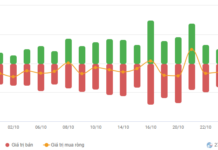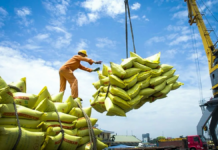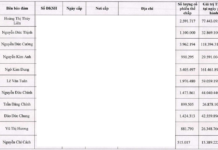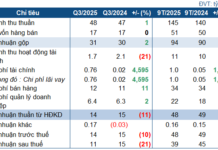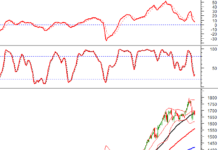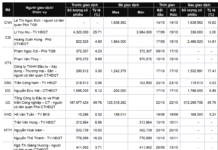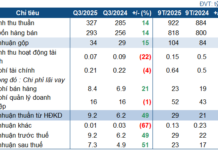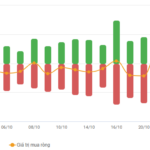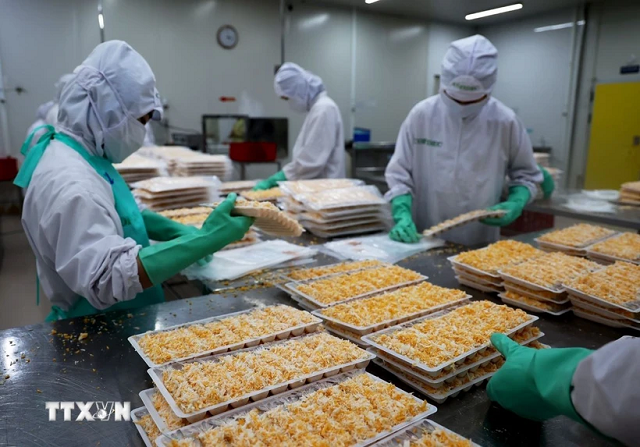
Vietnamsection>Seafood Export: Vietnam’s Strong Presence in the Singapore Market
|
According to statistics from the Vietnam Trade Office in Singapore, in the first nine months of 2024, Singapore imported seafood from nearly 100 countries and territories, with a total import turnover of approximately 839.1 million SGD (635.24 million USD), a decrease of 4.51% compared to the same period in 2023.
However, Vietnam remains among the top seafood exporters to Singapore and, for the first time, Vietnamese seafood has maintained its 5th rank for three consecutive quarters.
Data from Singapore’s Enterprise Governance Agency reveals that the largest seafood groups in the Singaporean market are: Shrimp, crab, and crustaceans (HS0306), accounting for 24.24% of market consumption; followed by Fresh fish (HS0302) at 18.71%; Frozen fish (HS0303) at 18.55%; Chilled or frozen fish fillets (HS0304) at 16.94%; and Mollusks (HS0307) at 10.46%.
Other product groups such as fresh fish, processed fish, and aquatic products account for relatively lower proportions, at 3.55%, 4.81%, and 2.73%, respectively.
Among the top 15 seafood exporters to Singapore, Malaysia remains in the lead, followed by Indonesia, Norway, China, and Vietnam, which has maintained its 5th position for three consecutive quarters.
The seafood market share in Singapore is generally evenly distributed among its trading partners, as each country has its own export strengths. The top six countries with the largest market share range from 9-13%, specifically Malaysia (13.42%), Indonesia (10.98%), Norway (10.34%), China (9.81%), Vietnam (9.22%), and Japan (8.42%).
Malaysia excels in fresh fish and shrimp, crab, and crustacean products, with a market share of 31.35% and 20.24% in these segments, respectively. Norway and Spain specialize in fresh chilled fish and frozen fish products.
Vietnam dominates the Singaporean seafood market with frozen fish fillets (accounting for 29.57%) and processed fish products (19.57%).
China has an advantage in mollusk products (29.34% market share), while Japan excels in aquatic products (40.16% market share). The remaining market share is divided among over 90 other partners, including Chile, India, Australia, Thailand, and the USA.
In line with its policy of diversifying supply sources, Singapore continuously seeks to expand its import markets through various strategies, intensifying competition among seafood exporters to the city-state.
In the first nine months of 2024, Vietnam’s seafood exports to Singapore decreased by 2.51% (with an export value of nearly 77.36 million SGD) and accounted for a 9.22% market share. While there was a significant increase in the export of fresh fish (HS0301) at 19.33%, there were substantial decreases in three other product groups: Chilled fish (down 46.56%), Frozen fish (down 35.42%), and Aquatic products (HS0308) (down 35.9%).
According to Mr. Cao Xuan Thang, Commercial Counselor and Chief of the Vietnam Trade Office in Singapore, these statistics highlight the importance of Vietnamese seafood in the Singaporean market.
However, to sustainably increase market share and enhance the value of seafood exports to Singapore, Vietnam needs to further improve the quality of its seafood products.
Additionally, high inflation and a tendency towards tighter spending present significant challenges for seafood exporters to Singapore, including Vietnam. Countries that can optimize logistics advantages and minimize costs will have a competitive edge in exporting goods to Singapore.
Do Van
The Red Book Blues: Unraveling the Mystery of Vietnam’s Land Ownership Exclusions
Article 151 of the Land Law 2024 outlines the circumstances under which individuals are ineligible to receive the Certificate of Land Use Rights and Ownership of Assets Attached to the Land (referred to as the Certificate). These circumstances encompass instances where the land user is ineligible and where the assets attached to the land are ineligible for certification.
The Ever-Changing Landscape of Hanoi’s Social Housing: From Affordable to a Few Billion Dreams
The Hanoi apartment market is experiencing a significant surge in prices, with social housing costs skyrocketing to a range of VND 40-45 million per square meter, and some units even exceeding VND 50 million. Prospective buyers are now facing the reality that purchasing social housing comes with a hefty price tag, requiring billions of VND to even enter the conversation. This unprecedented rise in prices has caught the attention of many, highlighting the changing landscape of the real estate market in Hanoi.
“Comprehensive Economic Partnership Agreement Signed Between Vietnam and UAE”
The CEPA is a groundbreaking free trade agreement, marking the first of its kind between Vietnam and an Arab nation. This agreement ushers in a new era of enhanced and substantive relations between Vietnam and the UAE, as well as the wider Arab world.

